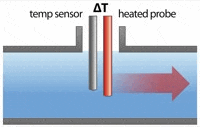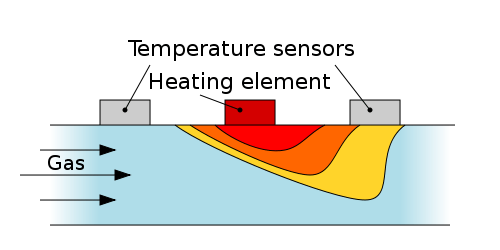Thermal mass flow meters employ the thermal dispersion principle whereby the rate of heat absorbed by a fluid flowing in a pipe or duct is directly proportional to its mass flow.
In a typical thermal flow meter gas flowing over a source of heat absorbs the heat and cools the source.
Thermal Mass Flow Meter
As flow increases, more heat is absorbed by the gas. The amount of heat dissipated from the heat source is proportional to the gas mass flow and its thermal properties.
Therefore, measurement of the heat transfer supplies data from which a mass flow rate may be calculated.

Thermal mass flow meters are designed to accurately monitor and measure the mass flow (as opposed to measuring volumetric flow) of clean gases, a parameter that is not temperature-dependent.
Therefore, the thermal mass flow meter does not require a correction for changes in gas temperature, pressure, viscosity, and density.

Advantages of Thermal Mass Flow Meter
- Measure gas mass flow rate directly
- Suitable for applications where temperature and pressures fluctuate
- Highly accurate and repeatable measurements with a typical accuracy of ± 1% FS
- Able to measure accurately low gas flow rates or low gas velocities
- Excellent turndown ratio, typically 50:1
- No moving parts
Limitations of Thermal Mass Flow Meter
- Gas mass meter use is limited to clean, non-abrasive fluids
- The presence of moisture or droplets can lead to measurement inaccuracy
- Thermal properties must be known: variation from calibrated values can cause inaccuracies
- Relatively high initial cost
Applications of Thermal Flow Meter
Thermal mass flow meters are suitable for a variety of processes requiring mass flow measurement and are frequently used for the regulation of low gas flows.
Some common gas flow applications for thermal mass flow meters include:
- Compressed air flow and distribution
- Natural gas consumption eg for burner and boiler feed control
- Monitoring and control of stack or flue gas (where composition known)
- Landfill gas recovery
- Flare gas measurement
- Gas flow mixing & blending
- Gas leak testing and detection
If you liked this article, then please subscribe to our YouTube Channel for Instrumentation, Electrical, PLC, and SCADA video tutorials.
You can also follow us on Facebook and Twitter to receive daily updates.
Read Next:
- Magnetic Meter Operation
- Ultrasonic Doppler Flow Meter
- Wedge Flow Meter Theory
- Mass Flow Meter Animation
- Flow Meter Verification
Thanks sir,
you articles are very helpfull,
please can you send me proper way of calibrating a thermal mass flow meter
i have fox thermal instrument inc model FT3, PLEASE I NEED TO CALIBRATE THIS
need your help to guide me thanks.
Thankyou sir for knowledge sharing material is very helpful.
Good knowledge it’s really helpful